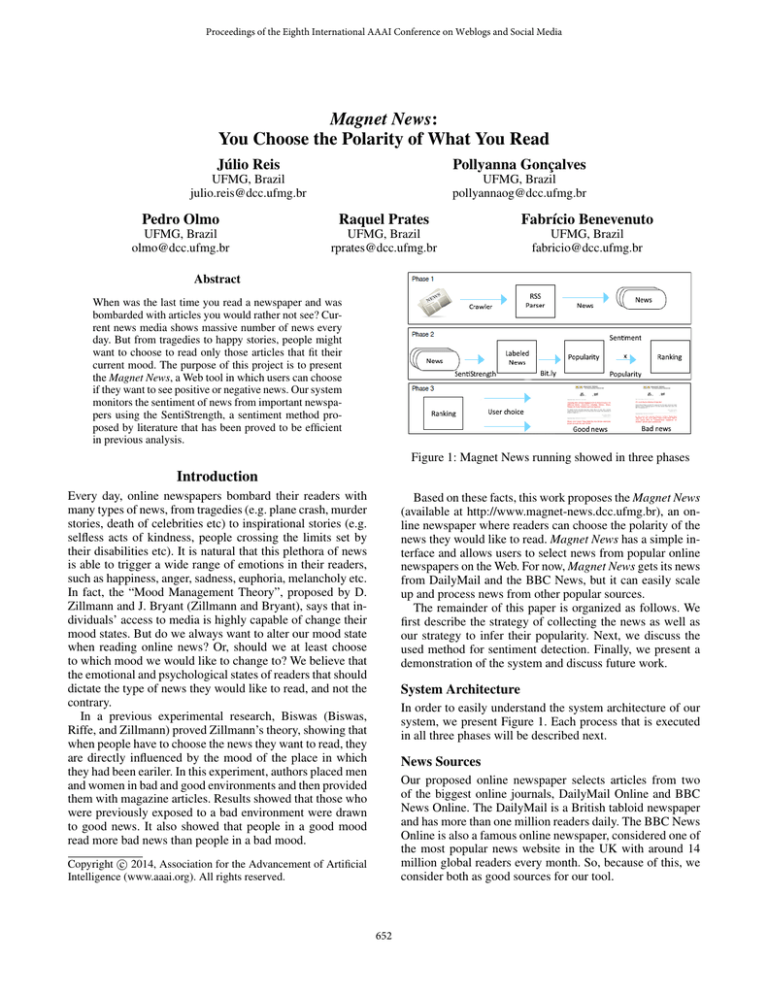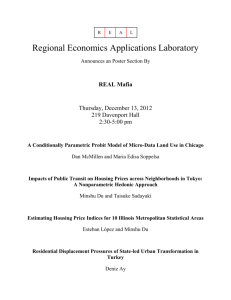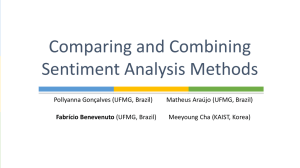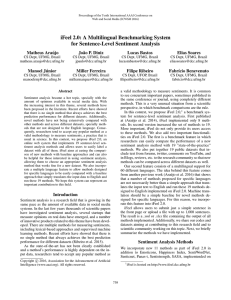
Proceedings of the Eighth International AAAI Conference on Weblogs and Social Media
Magnet News:
You Choose the Polarity of What You Read
Júlio Reis
Pollyanna Gonçalves
UFMG, Brazil
julio.reis@dcc.ufmg.br
Pedro Olmo
UFMG, Brazil
olmo@dcc.ufmg.br
UFMG, Brazil
pollyannaog@dcc.ufmg.br
Raquel Prates
UFMG, Brazil
rprates@dcc.ufmg.br
Fabrı́cio Benevenuto
UFMG, Brazil
fabricio@dcc.ufmg.br
Abstract
When was the last time you read a newspaper and was
bombarded with articles you would rather not see? Current news media shows massive number of news every
day. But from tragedies to happy stories, people might
want to choose to read only those articles that fit their
current mood. The purpose of this project is to present
the Magnet News, a Web tool in which users can choose
if they want to see positive or negative news. Our system
monitors the sentiment of news from important newspapers using the SentiStrength, a sentiment method proposed by literature that has been proved to be efficient
in previous analysis.
Figure 1: Magnet News running showed in three phases
Introduction
Every day, online newspapers bombard their readers with
many types of news, from tragedies (e.g. plane crash, murder
stories, death of celebrities etc) to inspirational stories (e.g.
selfless acts of kindness, people crossing the limits set by
their disabilities etc). It is natural that this plethora of news
is able to trigger a wide range of emotions in their readers,
such as happiness, anger, sadness, euphoria, melancholy etc.
In fact, the “Mood Management Theory”, proposed by D.
Zillmann and J. Bryant (Zillmann and Bryant), says that individuals’ access to media is highly capable of change their
mood states. But do we always want to alter our mood state
when reading online news? Or, should we at least choose
to which mood we would like to change to? We believe that
the emotional and psychological states of readers that should
dictate the type of news they would like to read, and not the
contrary.
In a previous experimental research, Biswas (Biswas,
Riffe, and Zillmann) proved Zillmann’s theory, showing that
when people have to choose the news they want to read, they
are directly influenced by the mood of the place in which
they had been eariler. In this experiment, authors placed men
and women in bad and good environments and then provided
them with magazine articles. Results showed that those who
were previously exposed to a bad environment were drawn
to good news. It also showed that people in a good mood
read more bad news than people in a bad mood.
Based on these facts, this work proposes the Magnet News
(available at http://www.magnet-news.dcc.ufmg.br), an online newspaper where readers can choose the polarity of the
news they would like to read. Magnet News has a simple interface and allows users to select news from popular online
newspapers on the Web. For now, Magnet News gets its news
from DailyMail and the BBC News, but it can easily scale
up and process news from other popular sources.
The remainder of this paper is organized as follows. We
first describe the strategy of collecting the news as well as
our strategy to infer their popularity. Next, we discuss the
used method for sentiment detection. Finally, we present a
demonstration of the system and discuss future work.
System Architecture
In order to easily understand the system architecture of our
system, we present Figure 1. Each process that is executed
in all three phases will be described next.
News Sources
Our proposed online newspaper selects articles from two
of the biggest online journals, DailyMail Online and BBC
News Online. The DailyMail is a British tabloid newspaper
and has more than one million readers daily. The BBC News
Online is also a famous online newspaper, considered one of
the most popular news website in the UK with around 14
million global readers every month. So, because of this, we
consider both as good sources for our tool.
Copyright c 2014, Association for the Advancement of Artificial
Intelligence (www.aaai.org). All rights reserved.
652
Again, we emphasize that our system’s design allows us
to collect news from other sources easily. Every day, our
crawler collects the latest news from each RSS of the considered sources. A RSS (Rich Site Summary), also called
“feed”, is a format for delivering regularly changing web
content and is used by most of news-related sites and others
online publishers syndicate. Whereas these feeds can be easily accessed, the only arduous process of crawling news is
to parse the RSS of each source, since they could be slightly
different. After collecting the RSS, our database consists of
information from each article, such as title, description and
text.
(a) Good news
(b) Bad news
Figure 2: Screen snapshots of the system when users select
to read the good news
Ranking Strategy
In order to define which news should be highlighted in our
Web tool, we rank them by a relation between its sentiment
score and its popularity. In the next section, we will describe
our strategy of get the popularity of each news article. Now,
let’s assume that S(a) is the sentiment score of an article a,
and P(a) as the normalized popularity of that same article.
So, the relation between the sentiment score and the popularity of the article a, R(a), can be described by the equation
below:
could increase the execution time of the method for sentiment detection, it would be interesting to identify which
fields would really be relevant to identify an articles sentiment. So, in order to analyze the correlation among the articles title and text, we conducted an experiment with 300
collected articles. The Pearson’s correlation (p) calculated
was equal to 0.2656, implying that there is a low linear correlation between the two variables. Although this correlation
is positive, it is not very strong. So, we chose to label each
articles polarity by analyzing the sentiment of its text corpus,
and not only its title.
R(a) = S(a) ⇤ P (a)
(1)
With this strategy, we can order the articles that will appear at Magnet News by its sentiment score and popularity.
Demo Scenarios
In this section, we present demonstrations of the Magnet
News execution. Figure 2(a) shows the execution of the system when a user chooses to read the good news and bad
news, respectively.
As we can see, besides presenting a list of news with the
polarity selected, the system also shows the popularity (total number of clicks) and the polarity (the result of SentiStrength method) of each article. By publishing Magnet
News, we hope that people could simply use it in order to select the type of news they want to read based on their current
mood. As a natural extension of this tool, we would like to
add more online news such as NewYorkTimes, CNN, Wall
Street Journal and so on.
Link Popularity
In this work, we infer the popularity of an article using
Bit.ly1 . Bit.ly is a well-used URL shortening service that
shortens billions of links per month (Antoniades et al.). The
service’s API provides the possibility of checking the total
number of clicks that a shorten link has received. What is
interesting here is that the service keeps the same shorten
URL for requisitions of the same long URL. For example, if
a user requests to shorten www.dummy.com, Bit.ly will return a shortened URL such as http://bit.ly/dummyID. But, if
another user tries to shorten the same URL, the system will
also return http://bit.ly/dummyID. This is important for us
since the global number of clicks in a shorten URL provides
a good estimation of popularity.
References
Antoniades, D.; Polakis, I.; Kontaxis, G.; Athanasopoulos, E.;
Ioannidis, S.; Markatos, E. P.; and Karagiannis, T. 2011. We.b:
The web of short urls. In 20th International Conference on World
Wide Web, 715–724. ACM.
Araújo, M.; Gonçalves, P.; Benevenuto, F.; and Cha, M. 2014. ifeel:
A system that compares and combines sentiment analysis methods.
In WWW (Companion Volume). International World Wide Web
Conference (WWW’14).
Biswas, R.; Riffe, D.; and Zillmann, D. 1994. Mood influence
on the appeal of bad news. Journalism and Mass Communication
Quarterly 71(4):689–696.
Gonçalves, P.; Araújo, M.; Benevenuto, F.; and Cha, M. 2013.
Comparing and combining sentiment analysis methods. In 1st
ACM Conference on Online Social Networks (COSN’13).
Zillmann, D., and Bryant, J. 1985. Affect, mood, and emotion as
determinants of selective exposure. Selective Exposure to Communication 157–190.
Sentiment Score Method
Sentiment analysis has been a hot topic in studies which analyze Web media (Gonçalves et al.). Thus, in order to be
able to label the news articles collected by our system as bad
or good news, we used SentiStrength, a machine-learningbased algorithm that detects sentiments in texts in a scale
ranging from -5 (very negative) to +5 (very positive). SentiStrength was chosen because it was shown in a previous
analysis (Gonçalves et al.) to be the method with better accuracy and coverage. SentiStrength method is available for
testing in iFeel (Araújo et al.).
As we have presented before, our daily collection generated some information about each article, such as title, description, and its text. As processing all these information
1
http://bit.ly
653







